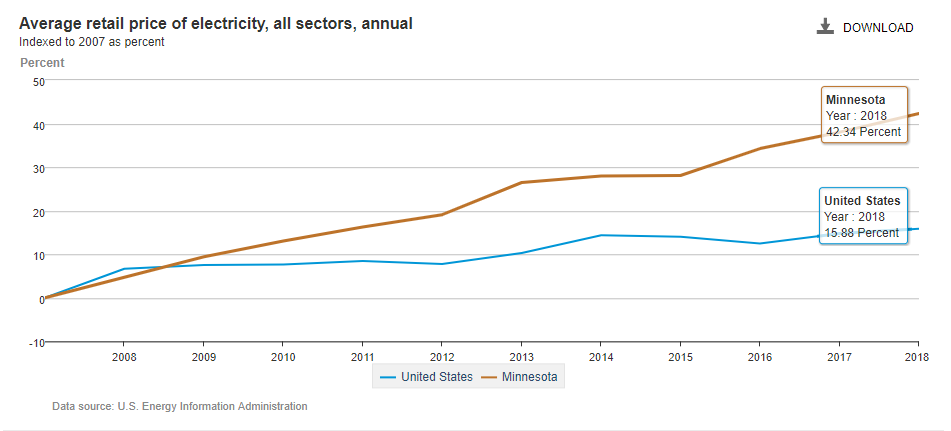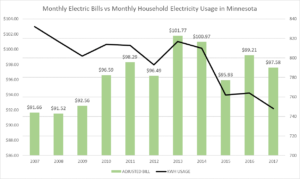Fresh Energy Is Still Intentionally Misleading Minnesotans on Energy Issues: Part One – Electricity Rates
Fresh Energy, a renewable energy advocacy organization, continues to mislead Minnesotan’s on energy issues – and it appears they don’t appreciate our work explaining how wind and solar are driving up the cost of electricity in our state.
In their latest critique of American Experiment, Fresh Energy made multiple attempts to inaccurately portray our organization as misunderstanding how electric rates work, while arguing that wind and solar are the cheapest sources of electricity in the state and are a boon to job creation.
Each of these claims is demonstrably false.
The article below is the first in a series of articles that will thoroughly explain how Fresh Energy continues to mislead Minnesotan’s on the cost of electricity in our state.
Why Electricity Rates Matter
According to U.S. Energy Information Administration (EIA) data, electricity rates in Minnesota have increased 26 percent faster than the national average since 2007, when then-governor Tim Pawlenty signed the Next Generation Energy Act (NGEA) into law.

Fresh Energy argues that the increase in electricity rates occurred because utility companies needed to raise their prices due to decreasing electricity sales since that time. (Decreasing sales means decreasing revenue streams, and in order to pay for the many fixed costs utility power plants have, utilities need to pass-on higher rates to consumers).
However, this argument rests on the premise that utility spending would remain flat or decrease (thus maintaining or reducing total revenue), as they would have if no major investments were made in renewable energy. Unfortunately, since the passage of the NGEA in 2007, utility spending has increased substantially due to enormous investments in wind and solar energy – throwing a wrench in Fresh Energy’s entire analysis.
As Fresh Energy wrote in an earlier critique of American Experiment’s report, Energy Policy in Minnesota: The High Cost of Failure:
“When consumers reduce electricity usage, many utility costs—like the fuel that would have been used in the power plant—are avoided, but some—like the administrative costs of running the company—are fixed and will still need to be recovered from customers. So, in the EIA’s rates calculation, the denominator is decreased more than the numerator, making the “rate” appear to increase. In reality, the customer savings far outweigh the increased “rate,” but focusing only on the EIA rates calculation, as CAE did, paints an incomplete and deceptive picture [Emphasis added].”
A closer look at the data shows that the incomplete picture is being painted by Fresh Energy.
The equation used by EIA to calculate average electricity rates looks like this:
[Electricity Rates (cents/kwh) = Total Revenue / Total Electricity Sales]
By saying that “the denominator is decreased more than the numerator,” Fresh Energy is assuming that both Total Revenue and Electricity Sales decreased since 2007, albeit at different rates.
However, the numerator (Total Revenue) hasn’t decreased at all. In fact, according to data from the Energy Information Administration (EIA), Total Revenues have increased by nearly 13 percent from 2007 to 2017, in inflation adjusted dollars, because as government approved monopolies utilities increased their spending on renewable energy, these costs were automatically incorporated into higher Total Revenue for the utility companies.
This is despite the fact that Total Electricity Sales (the denominator) declined by 3.5 percent. This means Minnesota ratepayers are paying substantially more money for less electricity, in real terms.
Clearly, Fresh Energy missed an important piece of the puzzle in their analysis: electricity rates aren’t just increasing to adjust for decreasing electricity sales, but to pay for the investments in renewable energy that require substantial revenue streams.
How do we know this? Utilities have admitted as much in filings submitted to the Public Utilities Commission (PUC), for one. Additionally, we can simply look at the math using Fresh Energy’s method.
Even if we assumed that Total Revenue remained constant from 2007 to 2017, even though they would have declined if Fresh Energy was correct in stating lower Total Electricity Sales would lead to lower Total Revenue, electric bills would have remained flat since 2007, in inflation-adjusted dollars.
Instead, electric bills rose by 8 percent, despite the average Minnesota household reducing electricity consumption by 10 percent.

Electric bills in Minnesota have been steadily climbing, in inflation adjusted dollars, since the passage of the NGEA in 2007, despite electricity consumption decreasing by 10 percent.
Additionally, electric bills should have actually decreased in this scenario after considering that population growth resulted in the addition of more than 100,000 new electricity customers in the state, equating to a 6 percent increase in the number of ratepayers in Minnesota from 2007 to 2017. Because there are now more people to recover costs from, each Minnesotan should have seen their electric bills decrease by at least 6 percent in inflation-adjusted dollars.
Here’s how Fresh Energy got it so wrong on electric rates:
According to EIA data, Total Revenue from residential electricity sales in 2007 equaled $2.18 billion, or $2.49 billion in 2017 dollars, while residential Total Electricity Sales were 22.357 billion kilowatt hours (kwh).
This would mean 2007 Electricity Rates would be 11.01 cents per kwh (in 2017 dollars).
[11.01 cents/kwh = $2.49 BILLION / 22.645 BILLION kwh]
If Minnesota ratepayers were asked to pay more for each unit of electricity they consumed to compensate for lower electricity sales, as Fresh Energy suggests, electricity rates, based on 2017 electricity sales and a constant revenue from 2007, would have only increased by 3.6 percent to 11.54 cents per kwh.
[11.54 cents/kwh = $2.49 BILLION / 21.573 BILLION kwh]
However, electricity rates in 2017 were much higher. According to EIA, Total Revenues in 2017 were $2.81 billion and Total Electricity Sales declined to 21.573 billion kwh, resulting in a rate of 13.04 cents per kwh.
[13.04 cents/kwh = $2.81 BILLION / 21.573 BILLION kwh]
This means residential Electricity Rates increased by 18 percent since 2007 and were nearly 13 percent higher than what they would have been if Fresh Energy’s theory about the reason for increasing electricity rates were correct.
As you can see, Fresh Energy skipped over an important part of the equation: Total Revenue. This is either due to a misunderstanding of the impact that large investments for renewable energy have on electricity rates, or a refusal to acknowledge it.
Although Fresh Energy correctly pointed out that the denominator – electricity sales – has been decreasing since 2007, they completely missed the fact that the numerator – what is known as the “revenue requirement” – has been increasing, and this is driving the increase in both rates and bills.
The Revenue Requirement Determines the Electricity Rate
When utility companies need to increase rates due to lagging revenues caused by decreasing electricity sales or increased spending, they need to file a request to the Minnesota Public Utilities Commission (PUC) for justification.
These requests are known as “rate cases.”
Fresh Energy claims that rates are increasing to adjust for a loss in electricity sales. If that were true, then utilities would say exactly that in their rate cases.
But they don’t.
In Xcel Energy’s most recent rate case in 2015, the company plainly explained why it was requesting to increase electricity prices on its customers:
The Company’s revenue deficiency in 2016 reflects the costs of significant investments in our system, both in 2015 and over the next several years, as we continue to invest in carbon free energy sources and replace critical infrastructure while preparing for the future. These investments are resulting cleaner air, a better environment and a more resilient, flexible and reliable energy system that can deliver value to our customers for decades to come, but they require sufficient revenues to support them.
Clearly, Xcel requested to increase rates not merely to adjust for a reduction in electricity sales, but because enormous investments in renewable energy are increasing its need for additional revenue.
You see, when a utility company like Xcel Energy retires a coal plant in favor of wind or solar (and natural gas), they aren’t replacing one expensive power plant with another. Coal plants are oftentimes fully depreciated power plants with zero capital investments left to pay off – meaning the electricity they generate comes at a significant bargain compared to newer power plants. Replacing fully-depreciated and affordable coal generation with intermittent renewable energy and the backup natural gas capacity necessary to maintain grid reliability always comes at a cost to ratepayers.
You only need to do the math to see that investments in renewable energy have resulted in 18 percent higher electricity rates and 8 percent higher electric bills for Minnesotan’s, despite their efforts to reduce electricity consumption by 10 percent per household.
Because energy conservation practices were coupled with irresponsible investments in renewable energy, Minnesota ratepayers are receiving little to no reward for reducing the amount of electricity they use each month, which will be discussed in part two of our series.